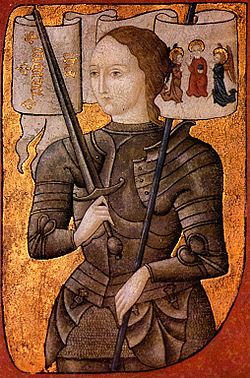

 Joan of Arc: Patriot and Saint
Joan of Arc (1412-1431) was a French teenager and devout Catholic who became one of the greatest military leaders of all time. Only 17 years old when she was put in command of the French army, Joan of Arc is the youngest person to ever command a national military force – a feat that is all the more remarkable considering she was a girl. When Joan entered into her mission, she went by the name Jeanne la Pucelle, or “Joan the Maid.” In French, her real name was Jeane d’Arc although she signed her name as “Jehanne.” Joan was born on January 6, 1412, in the village of Domremy to Jacques and Isabelle d’Arc. Joan had three brothers and one sister. According to contemporary accounts Joan was a dutiful, sweet-natured child. Jean Morreau, her godfather said “she was such a good girl that almost everyone in Domremy loved her.” Joan’s father owned a large farm at the edge of the village. As the daughter of a farmer, Joan grew up herding cattle and sheep in addition to making hay and helping in the fields at harvest time. Joan was taught domestic skills such as cooking and sewing by her mother and would later say, “As for spinning and sewing, I fear no woman in Rouen.” She also said, “It was my mother alone who taught me the ‘Our Father’ and ‘Hail Mary’ and the ‘Creed;’ and from none other was I taught my faith.” Joan knew her catechism and her prayers and the histories of the saints. She did not go to school and never mastered reading or writing, yet she demonstrated great knowledge and articulation when speaking. Although Joan’s mother did not have any schooling either, Isabel serves as a model to many a mother who boasts of a good education but does not teach her children. For nearly 100 years, a war had been going on between France and England over claims by the English kings to the French throne. By 1422, the English and their allies the Burgundians had overrun most of northern France, including Paris. The prince who should have been the king of France had never been crowned. Just when the country was losing heart, when people felt they would never find a leader to help them fight the English, Joan of Arc appeared on the scene. Joan was deeply religious and her faith was not founded on rituals or superstitions, but based on obedience to God and fear of the Lord. She was personally committed to purity and devoted to helping the poor and the sick, while she also had a great love for her country. At the age of 13, Joan started having visions and heard voices that she believed were from heaven. They told her to be good and attend church often, and one day she would drive out the enemies of France with God’s help. Joan confided to no one about this for three years, until the voices told her it was time to set forth on her mission. Her family and the village priest tried to talk her out of it, but she was determined to see Charles (later King Charles VII), the uncrowned leader of the French people. When Joan arrived in the throne room, Charles was not on the throne. He had hidden himself among his courtiers. Nevertheless, Joan walked straight toward Charles and knelt before him. This convinced him that Joan had powers given to her by God. He put her in charge of his troops, so that she might win his kingdom back for him. At first the soldiers laughed at this simple peasant girl who had never even ridden a horse and who wanted to lead them in battle. Nevertheless, while sitting on a fine black horse, dressed in a suit of armor and carrying a white banner embroidered with the lilies of France, Joan led them to victory. In 1429 with an army of 12,000 men she freed the city of Orleans from the English. Then she led an army to Rheims, capturing forts and towns along the way and making it safe for Charles to follow. When Charles was at last crowned King Charles VII in the great cathedral of Rheims, Joan had a place of honor at his side. Joan and her family were elevated to nobility. Joan had been able to unite the French so that they worked together to succeed together. While Joan’s fellow countrymen were celebrating her as France’s greatest heroine, the English were plotting to destroy her. Their intent was to discredit Joan with the ultimate goal of making the crowning of Charles VII illegitimate. In 1430, the Burgundians captured Joan and sold her to the English. The King of France did not make any attempt to rescue her, and many condemned him for failing to intervene. Joan herself attempted several escapes, on one occasion jumping from a 70-foot tower. Her trial was conducted under the authority of the Church. However, the English paid for and deliberately rigged the outcome so that Joan would be found guilty. Unable to establish suitable grounds on which to formally charge her, they sought to find some other offense such as witchcraft and/or heresy. Though her appearance is often feminized in paintings, Joan had dressed as a man and kept her hair cut short during the military campaign. According to medieval clothing expert Adrien Harmand, she wore two layers of trousers in which the outer pants were made of boot leather and securely attached to a doublet with 20 fasteners. This would not only better suit Joan’s occupation, but would also safeguard her chastity while camped out in the field with the soldiers. In prison, Joan was made to promise never to wear men’s clothes again on the condition that she would be removed from the military prison and held in female custody. But they stole her dress and she was forced to put on a man’s garment. Thus, Joan was pronounced a relapsed heretic. On May 30, 1431, at the age of 19 she was burned at the stake in the square of Rouen, France. Clutching a cross as the flames leapt up around her, Joan’s last words were said to be “Jesus, Jesus, Jesus” and an English soldier reportedly cried, “We have burned a saint.” The Hundred Years’ War continued for 22 more years. Charles VII succeeded in retaining legitimacy as King of France in spite of a rival coronation held for Henry VI in December 1431. Twenty years after Joan’s death, the Church launched a Trial of Nullification. In 1456, as a result of their six year investigation into Joan of Arc’s life and the transcripts of her trial at Rouen, the Church overturned Joan’s conviction. According to the Church’s ruling, Joan was a martyr who was wrongly executed by corrupt partisan clergy abusing a Church trial for secular purposes. Nearly 500 years later, she was declared a saint by the Roman Catholic Church. Joan of Arc’s feast day is celebrated every year on May 30th. Joan of Arc’s life is probably the best documented of anyone in the Middle Ages thanks to the records that were kept by the Catholic Church, which provide a wealth of information that historians have used for centuries. Joan of Arc’s courage and determination gave hope to all of France in its fight against the English. Her patriotism was more than a sentiment – it was a passion. This brave young lady led troops into battle and in the midst of fighting would shout words of encouragement to the men. In only a couple of months she was able to completely reverse a war that had been going on for almost 100 years. Joan’s accomplishment at such a young age is unparalleled in history. The whole world has never forgotten Joan’s heroism and fortitude. American author Mark Twain was so intrigued by her story that he wrote a remarkably accurate historical novel about Joan’s life and mission called The Personal Recollections of Joan of Arc. Her story continues to fascinate and inspire people of all ages. REFERENCES http://www.stjoan-center.com (Saint Joan of Arc Center, Albuquerque, NM) http://archive.joan-of-arc.org/index.html (Joan of Arc archive.) http://www.maidofheaven.com (All About Joan of Arc.) http://www.ewtn.com/library/MARY/JOAN1.htm (The Holiness of Saint Joan of Arc, by Etienne Robo.) http://csis.pace.edu/grendel/WS2/research1.html (The Life of St. Joan of Arc, by Lei Takahashi.) http://joan-of-arc.org/joanofarc_life_summary_.html (Joan of Arc life summary.) http://www.spiritus-temporis.com/joan-of-arc (Joan of Arc biography, clothing, trivia, and more.) http://www.fordham.edu/halsall/source/joanofarc.html (Joan of Arc’s letter to the King of England.)
Maid of Heaven: The Story of Saint Joan of Arc
Joan of Arc
Joan of Arc (Landmark Books)
Joan of Arc (Wishbone Classics #4)
Contact: . Thanks! Please click here for reprint permission.


These pages are a continuous work in progress.
|
Help Support this Site
and purchase items via our affiliate links. Thank you!
 
Thank you for visiting my |

